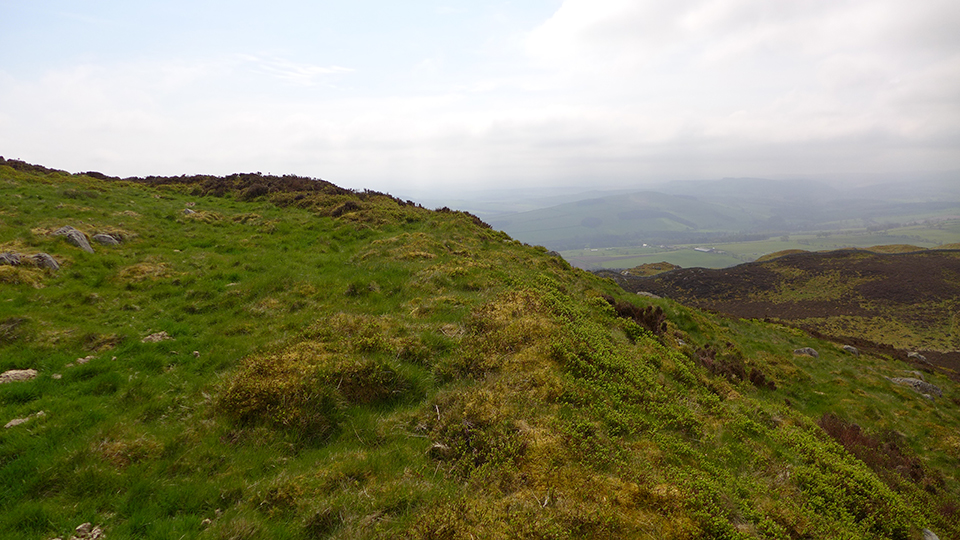
12/05/2016 – Walls and outcrops of Rubers Law

12/05/2016 – Walls and outcrops of Rubers Law

12/05/2016 – Top of Rubers Law, a very white trigpoint.

12/05/2016 – View from Rubers Law hillfort

12/05/2016 – Rubers Law hillfort’s natural defences

12/05/2016 – Walls of Rubers Law hillfort

12/05/2016 – Rubers Law from Black Law
12/05/2016 – If you are thinking of visiting one of the two hills mentioned in local rhyme posted by Rhiannon below I’d pick Rubers Law over Dunion Hill any day of the week.
Access can be gained from most directions but I liked the walk from Denholm (nice coffee shop there) to the NW. Follow the footpath heading SE out of Denholm, then take the path through the trees which lead you first SW then SE. After that it’s a short climb up to the top.
The fort is on the summit of a great little rugged hill. Some nice overgrown walls to see but this fort’s best defence is the hill’s natural outcrops. Lovely site to walk around and great views from it.
A poor man from Jedburgh was on his way to one of the sheep markets held at Hawick at the end of every year to sell off sheep for slaughter. As he was passing over the side of ‘Rubislaw’ nearest the Teviot he was suddenly alarmed by a frightful and unaccountable noise which seemed to come from a multitude of female voices. He could see nothing of the speakers but heard the howling and wailing mingled with shouts of mirth and merriment, and he made out the words,
‘O there’s a bairn born, there’s naething to pit on’t.‘
The outcry was evidently occasioned by the birth of a fairy child, at which most of the fairy women rejoiced, while a few lamented the lack of anything to wrap the baby in.
Much astonished at finding himself in the midst of invisible beings in a wild moorland place, far from help should help be needed, the poor man, hearing the lament over and over again, stripped off his plaid and threw it on the ground. No sooner had he done so, than it was snatched up by an invisible hand, and the lamentations ceased, but the sounds of joy redoubled.
Guessing that he had pleased the invisible beings, the poor man lost no time in continuing on his way to Hawick market. There he bought a sheep which proved a remarkably bargain, and returned to Jedburgh. He never had cause to regret the loss of his plaid, for every day after that his wealth multiplied and he died a rich and prosperous man.
Folk-Lore And Legends: Scotland (1889)
The fort on Rubers Law is actually R*man it seems. But there have been plenty of finds of stone arrowheads and so on up here, according to the RCAHMS database.
It’s a very prominent isolated hill and has lots of Named Features, like Peden’s Pulpit:
We have said that Ruberslaw is memorable in Scottish story. It is so in one of its bloodiest and saddest pages. Its hollow dells and rocky recesses were the ‘hiding-places’ of the persecuted Covenanters; and upon its weird summit tradition still points out the stone upon which the martyr-preacher, Alexander Peden, laid his Bible when he poured forth his dauntless and fiery ‘message’ to our eager-listening and right-hearted forefathers.
The same article (in July 1853’s ‘Gentleman’s Magazine’) describes how the ‘stormy Ruberslaw’ assumes a grand and starling appearance when its top pokes through the rolling sheets of fog that hide its lower slopes. The weather is also mentioned in local rhyme, as recorded by William and Robert Chambers in their Edinburgh Journal v3, in 1835:
When Ruberslaw puts on his cowl,
The Dunion on his hude,
Then a’ the wives o’ Teviotside
Ken there will be a flude.
There’s also a “cavity cut in an earthfast block of freestone on the east side of Ruberslaw, vulgarly called ‘Simmie’s pottie’ but whether this would be used as a baptismal font or a knocking trough [for removing barley husks] is uncertain” (as you’ll see here ). It also has a holy well of St Mary’s.















